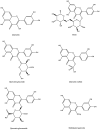Quercetin Regulates Lipid Metabolism and Fat Accumulation by Regulating Inflammatory Responses and Glycometabolism Pathways: A Review
- PMID: 38674793
- PMCID: PMC11053503
- DOI: 10.3390/nu16081102
Quercetin Regulates Lipid Metabolism and Fat Accumulation by Regulating Inflammatory Responses and Glycometabolism Pathways: A Review
Abstract
Fat synthesis and lipolysis are natural processes in growth and have a close association with health. Fat provides energy, maintains physiological function, and so on, and thus plays a significant role in the body. However, excessive/abnormal fat accumulation leads to obesity and lipid metabolism disorder, which can have a detrimental impact on growth and even harm one's health. Aside from genetic effects, there are a range of factors related to obesity, such as excessive nutrient intake, inflammation, glycometabolism disease, and so on. These factors could serve as potential targets for anti-obesity therapy. Quercetin is a flavonol that has received a lot of attention recently because of its role in anti-obesity. It was thought to have the ability to regulate lipid metabolism and have a positive effect on anti-obesity, but the processes are still unknown. Recent studies have shown the role of quercetin in lipid metabolism might be related to its effects on inflammatory responses and glycometabolism. The references were chosen for this review with no date restrictions applied based on the topics they addressed, and the databases PubMed and Web of Sicence was used to conduct the references research, using the following search terms: "quercetin", "obesity", "inflammation", "glycometabolism", "insulin sensitivity", etc. This review summarizes the potential mechanisms of quercetin in alleviating lipid metabolism through anti-inflammatory and hypoglycemic signaling pathways, and describes the possible signaling pathways in the interaction of inflammation and glycometabolism, with the goal of providing references for future research and application of quercetin in the regulation of lipid metabolism.
Keywords: glycometabolism; inflammation; lipid metabolism; obesity; quercetin.
Conflict of interest statement
The authors declare that the work was conducted in the absence of any commercial or financial relationships that could be construed as a potential conflict of interest.
Figures



Similar articles
-
The Effects of Quercetin on Vascular Endothelium, Inflammation, Cardiovascular Disease and Lipid Metabolism-A Review.Nutrients. 2025 May 3;17(9):1579. doi: 10.3390/nu17091579. Nutrients. 2025. PMID: 40362888 Free PMC article. Review.
-
The inhibitory effects of quercetin on obesity and obesity-induced inflammation by regulation of MAPK signaling.J Nutr Biochem. 2015 Nov;26(11):1308-16. doi: 10.1016/j.jnutbio.2015.06.005. Epub 2015 Jul 26. J Nutr Biochem. 2015. PMID: 26277481
-
Protective effect of quercetin on high-fat diet-induced non-alcoholic fatty liver disease in mice is mediated by modulating intestinal microbiota imbalance and related gut-liver axis activation.Free Radic Biol Med. 2017 Jan;102:188-202. doi: 10.1016/j.freeradbiomed.2016.11.037. Epub 2016 Nov 25. Free Radic Biol Med. 2017. PMID: 27890642
-
Quercetin reduces high-fat diet-induced fat accumulation in the liver by regulating lipid metabolism genes.Phytother Res. 2013 Jan;27(1):139-43. doi: 10.1002/ptr.4687. Epub 2012 Mar 23. Phytother Res. 2013. PMID: 22447684
-
Therapeutic Effects of Quercetin on Inflammation, Obesity, and Type 2 Diabetes.Mediators Inflamm. 2016;2016:9340637. doi: 10.1155/2016/9340637. Epub 2016 Nov 28. Mediators Inflamm. 2016. PMID: 28003714 Free PMC article. Review.
Cited by
-
Secondary Metabolites from a New Antibiotic-Producing Endophytic Streptomyces Isolate Inhibited Pathogenic and Multidrug-Resistant Mycobacterium tuberculosis Strains.Trop Med Infect Dis. 2025 Apr 23;10(5):117. doi: 10.3390/tropicalmed10050117. Trop Med Infect Dis. 2025. PMID: 40423347 Free PMC article.
-
Effects of Inonotus obliquus on ameliorating podocyte injury in ORG mice through TNF pathway and prediction of active compounds.Front Pharmacol. 2024 Aug 21;15:1426917. doi: 10.3389/fphar.2024.1426917. eCollection 2024. Front Pharmacol. 2024. PMID: 39234117 Free PMC article.
-
Crosstalk Between Antioxidants and Adipogenesis: Mechanistic Pathways and Their Roles in Metabolic Health.Antioxidants (Basel). 2025 Feb 10;14(2):203. doi: 10.3390/antiox14020203. Antioxidants (Basel). 2025. PMID: 40002389 Free PMC article. Review.
-
The Effects of Quercetin on Vascular Endothelium, Inflammation, Cardiovascular Disease and Lipid Metabolism-A Review.Nutrients. 2025 May 3;17(9):1579. doi: 10.3390/nu17091579. Nutrients. 2025. PMID: 40362888 Free PMC article. Review.
-
Phytochemicals in Cancer Chemoprevention: Preclinical and Clinical Studies.Cancer Control. 2024 Jan-Dec;31:10732748241302902. doi: 10.1177/10732748241302902. Cancer Control. 2024. PMID: 39629692 Free PMC article. Review.
References
-
- Powell-Wiley T.M., Poirier P., Burke L.E., Després J.P., Gordon-Larsen P., Lavie C.J., Lear S.A., Ndumele C.E., Neeland I.J., Sanders P., et al. Obesity and Cardiovascular Disease: A Scientific Statement from the American Heart Association. Circulation. 2021;143:e984–e1010. doi: 10.1161/CIR.0000000000000973. - DOI - PMC - PubMed
Publication types
MeSH terms
Substances
Grants and funding
LinkOut - more resources
Full Text Sources
Medical

